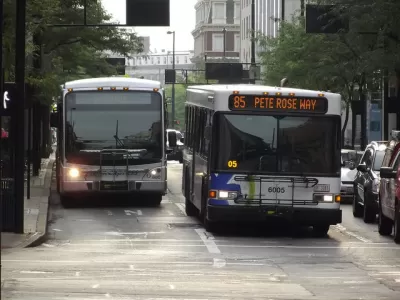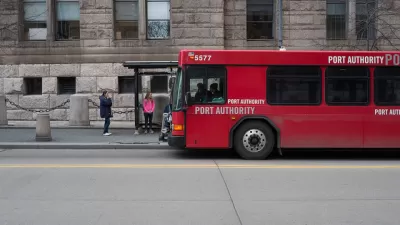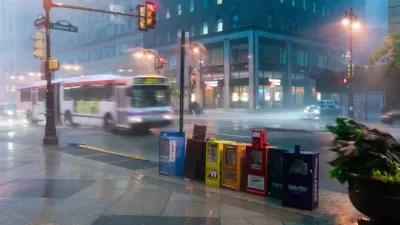The process of reducing the number of stops on a transit line—known as bus stop thinning, consolidation, or balancing—took effect this week in Cincinnati. Reducing the number of stops is intended to speed up buses and improve reliability.

"Cincinnati Metro riders using hundreds of the bus system's stops -- including some serving Cincinnati Public Schools' high school students -- had to catch their ride at a new location Monday morning, after the transit authority removed 400 stops over the weekend," reports Pat LaFleur.
The 400 stops were removed in the third phase of the FAStops program, launched a year ago with the intention of speeding up Cincinnati Metro buses.
"The theory behind the FAStops plan is to optimize bus stop spacing in order to keep buses moving more efficiently along their routes, Cincinnati Metro spokeswoman Brandy Jones told WCPO in 2018, shortly after the transit agency announced the program."
LeFleur's coverage of the stop removals focuses on the impact of the program on Metro lines serving routes to schools in the Cincinnati Public Schools system.
FULL STORY: Cincinnati Metro program removed hundreds of bus stops over the weekend

Study: Maui’s Plan to Convert Vacation Rentals to Long-Term Housing Could Cause Nearly $1 Billion Economic Loss
The plan would reduce visitor accommodation by 25,% resulting in 1,900 jobs lost.

North Texas Transit Leaders Tout Benefits of TOD for Growing Region
At a summit focused on transit-oriented development, policymakers discussed how North Texas’ expanded light rail system can serve as a tool for economic growth.

Why Should We Subsidize Public Transportation?
Many public transit agencies face financial stress due to rising costs, declining fare revenue, and declining subsidies. Transit advocates must provide a strong business case for increasing public transit funding.

How to Make US Trains Faster
Changes to boarding platforms and a switch to electric trains could improve U.S. passenger rail service without the added cost of high-speed rail.

Columbia’s Revitalized ‘Loop’ Is a Hub for Local Entrepreneurs
A focus on small businesses is helping a commercial corridor in Columbia, Missouri thrive.

Invasive Insect Threatens Minnesota’s Ash Forests
The Emerald Ash Borer is a rapidly spreading invasive pest threatening Minnesota’s ash trees, and homeowners are encouraged to plant diverse replacement species, avoid moving ash firewood, and monitor for signs of infestation.
Urban Design for Planners 1: Software Tools
This six-course series explores essential urban design concepts using open source software and equips planners with the tools they need to participate fully in the urban design process.
Planning for Universal Design
Learn the tools for implementing Universal Design in planning regulations.
Ascent Environmental
Borough of Carlisle
Institute for Housing and Urban Development Studies (IHS)
City of Grandview
Harvard GSD Executive Education
Toledo-Lucas County Plan Commissions
Salt Lake City
NYU Wagner Graduate School of Public Service





























